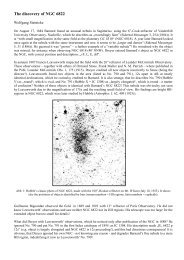John Louis Emil Dreyer – A Short Biography
John Louis Emil Dreyer – A Short Biography
John Louis Emil Dreyer – A Short Biography
Create successful ePaper yourself
Turn your PDF publications into a flip-book with our unique Google optimized e-Paper software.
Blackford Hill. It now owns more than 15000 books and manuscripts on astronomy, philosophy and science, many<br />
from the fifteenth and sixteenth centuries. The library is one of the largest of its kind. Naturally, <strong>Dreyer</strong> was a<br />
frequent visitor on Blackford Hill <strong>–</strong> meeting there Copeland, who was appointed the first director in 1889 and third<br />
Astronomer Royal of Scotland. Despite health problems lasting for nearly two years, <strong>Dreyer</strong>’s historical studies led<br />
to another important work: his History of Planetary Systems from Thales to Kepler, which was published in 1906 in<br />
Cambridge and is 432 pages long.<br />
In early 1910 the Royal Society and the Royal Astronomical Society decided to produce an edition of the<br />
complete work of William Herschel. 10 A committee was founded and <strong>Dreyer</strong> became a member. Given his broad<br />
knowledge about observing and cataloguing nebulae (especially concerning Herschel’s contribution) and history, he<br />
was the ideal person for this task. Consequently the editing of the bulky matter was up to him. The result was<br />
published in 1912 in two volumes with altogether 1441 pages: the Scientifi c Papers of Sir William Herschel. 11<br />
<strong>Dreyer</strong> not only revised Herschel’s three catalogues of non-stellar objects but also wrote an important biography,<br />
using unpublished material (the first chapter in Vol. I).<br />
For his important contributions to astronomy, <strong>Dreyer</strong> was awarded the RAS gold medal on 11 February 1916.<br />
Ralph Allan Sampson, President and fifth Astronomer Royal of Scotland, gave the laudation (Sampson 1916). At<br />
that time, <strong>Dreyer</strong> had nearly terminated his observations; his last entry in the notebook is dated 7 November 1914,<br />
treating the transit of Mercury. Since he was exclusively concentrated on historical studies, he eventually decided to<br />
resign from his office. In his last report of 1916 one reads that ‘The difficulty carrying on this work, which often<br />
requires that I should refer to rare old books, found from great libraries, and the desire to be able to devote my<br />
whole time to the work, have after much consideration decided me to resign from my appointment here and to<br />
remove to Oxford.’ 12<br />
An enduring issue in his 34-year office was financial problems. He always had to beg for money to operate<br />
the observatory, to maintain its instruments or for his publications. In contrast to Robinson, <strong>Dreyer</strong> had no<br />
assistants. Occasionally Charles Faris, who had already been employed by his predecessor in 1868, helped him with<br />
meteorological measurements. In Armagh <strong>Dreyer</strong> was a lone fighter, which did not suit his nature. He was very<br />
communicative, wrote and received many letters and was often visited by astronomers. 13 Among them were local<br />
figures, such as Robert Ball, Ralph Copeland and William Rambaut, but also people from the continent and even<br />
the United States. For instance, Edward Emerson Barnard and his wife Rhoda visited Armagh on 25 July 1893.<br />
<strong>Dreyer</strong>’s children and grandchildren were frequent guests too.<br />
In June 1917 Joseph Hardcastle was appointed as <strong>Dreyer</strong>’s successor. 14 Unfortunately, he suddenly died on 10<br />
November (at the early age of 49) without acceding to the office. Eventually William Ellison became the new<br />
Director of Armagh, holding the office until his death in 1936.<br />
Oxford<br />
From 30 September 1916 onwards <strong>Dreyer</strong> (now 64 years old) and his wife, Kate, lived in Oxford, at 14<br />
Staverton Road. Above all, the famous Bodleian Library promised new material for his historical studies. <strong>Dreyer</strong><br />
was engaged with a mammoth task: the edition of the complete work of Tycho Brahe. 15 Since 1908 he had<br />
frequently obtained manuscripts from the Royal Library in Copenhagen. The final work, funded by the Danish<br />
Carlsberg Institute and completely written in Latin, was to comprise 15 volumes; eight were published in Armagh<br />
(the first in 1913) and the remainder appeared in Oxford (the last three in 1929, after <strong>Dreyer</strong>’s death).<br />
Owing to the proximity to London, <strong>Dreyer</strong> was often present at RAS meetings. Together with Turner he<br />
edited the History of the Royal Astronomical Society, which appeared in 1923, covering the first 100 years (1820<strong>–</strong><br />
1920). 16 The chapters (treating 10-year periods until 1880) were written by several authors; <strong>Dreyer</strong> contributed<br />
those on the periods 1830<strong>–</strong>40 and 1880<strong>–</strong>1920.<br />
10<br />
Just after William Herschel’s death in 1822, his son <strong>John</strong> had planned such a work, but he found on inquiry that no publisher would be<br />
willing to undertake the risk.<br />
11<br />
<strong>Dreyer</strong> (1912); in 1918 he compiled a ‘Descriptive Catalogue of a Collection of William Herschel’s Papers’ for the RAS (<strong>Dreyer</strong> 1918).<br />
12<br />
Report Armagh Observatory 1916.<br />
13<br />
The ‘Visitor’s Book’ is stored in the Armagh archive.<br />
14<br />
Hardcastle was a grandson of William Herschel and member of the committee to edit his work.<br />
15<br />
See e.g. Gingerich (1982).<br />
16<br />
A second volume, covering 1920<strong>–</strong>80, appeared in 1987.











![SFB2011 Zeit [Kompatibilitätsmodus]](https://img.yumpu.com/4636501/1/190x135/sfb2011-zeit-kompatibilitatsmodus.jpg?quality=85)